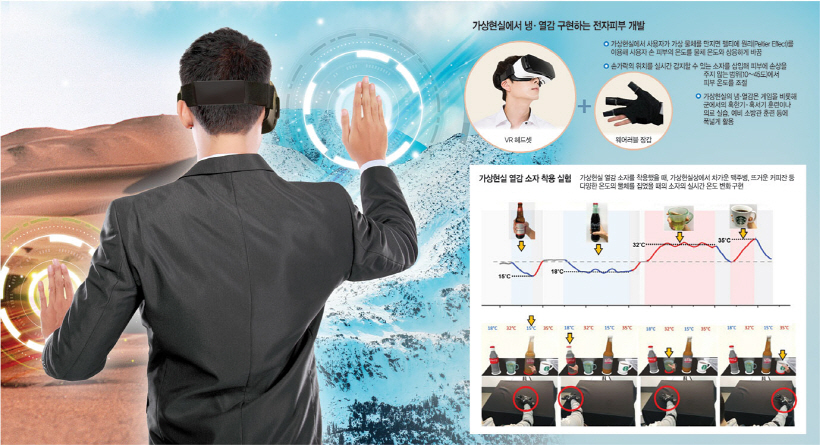Department News
[Munhwa Ilbo] Profs. Seung Hwan Ko and Dongjun Lee Develop Artificial Skin with Thermal Sensing in VR
[Economics] Science
Touching a Coke bottle in a fridge in VR space… You can feel how cold it is

▲ Graphics=Jae-woo Song
■ SNU Research Team Develops Artificial Skin with Thermal Sensing
World’s First Stretchable, Wearable Device
Not Limited to Visuals and Sounds Anymore
Temperature Controlled by ‘Peltier Effect’
Thermal Sensations When Touching Objects in VR Space
Possible Applications Include Military and Medical Training
The Future of VR Technology Recreating More Sophisticated Sensory Information
The COVID-19 pandemic has led us into a culture of social distancing and meetings, lectures, and even doctor appointments taking place online. With it, there has also been an increased interest in virtual reality and augmented reality technology that provide an immersive experience. However, the current VR and AR equipment typically focuses on visuals and sounds, without sensory input such as roughness, hardness, pressure, and temperature. So the actual feeling of touching an object cannot be recreated. But a Korean research team has recently developed a kind of artificial skin that recreates thermal sensations in virtual reality. The soft wearable thermo-haptic device allows the user to feel temperature upon touching a cold bottle of Coke or a warm coffee cup. Remote information technology that recreates temperature has existed, but this is the first time the world has seen a device made out of stretchable material that adheres to the skin. Perhaps we can look forward to VR technology that provides more sophisticated sensory information, just like in the Spielberg movie Ready Player One.
Professors Seung Hwan Ko and Dongjun Lee from the Dept. of Mechanical Engineering, of Applied Nano and Thermal Science Lab and Interactive & Networked Robotics Lab respectively, conducted a joint research on developing a wearable device that enables the user to feel thermal sensations in virtual reality. The research was published on the online version of Advanced Functional Materials on February 9th under the following title: “Stretchable Skin-Like Cooling/Heating Device for Reconstruction of Artificial Thermal Sensation in Virtual Reality.”
Researchers around the world have worked on developing a wearable device that can recreate the sensations that would be felt by a hand, which is highly receptive to external stimuli. The research team at SNU focused on temperature sensation. They developed a device that can artificially recreate the temperature the user feels upon contacting an object in VR space. The device is made to be stretchable and fit closely to the skin for user comfort. Enhanced heat transfer between the device and skin allows for a more immersive experience. Using the Peltier Effect, the team developed a way to artificially recreate the thermal feeling on the skin of the user’s hand, in accordance with the temperature of the virtual object in VR space. In addition, the wiring of the device was created in a form of the serpentine structure. The stress dispersion makes it possible for the device to be stretchable, like rubber. They also inserted the device in a wearable glove, detecting the position of each finger. The skin temperature is adjusted between 10 to 45 degrees Celsius, without causing harm to the skin. So it is possible to transmit thermal information such as temperature or thermal conduction when the user touches a cold bottle of beer or a hot coffee cup in VR space. The temperature sensations in VR can be used in not only gaming but also military, medical, and firefighter training. A recent MBC documentary depicts recreating and meeting a deceased daughter in VR; in the episode, the VR technology recreates subtle movements, gait, voice, and speech patterns of the daughter. “Adding a thermal sensation would have made the experience even more realistic,” said Prof. Ko. “We can visit places that are hard to access and even be reunited with people we can’t meet face to face.” He also added that “in order to fully utilize the potential advantages of virtual reality, it must be possible for the user to feel, not just see or hear things. This research, focusing on temperature which is one of many tactile sensations, will be a crucial first step.”
■ Terminology
Thermo-haptic device: A haptic device artificially creates sensory information. Scientists have developed haptic devices that recreate the sensation of force, vibration, and movement. On the other hand, a thermo-haptic device transmits thermal information via the user’s skin, such as temperature and thermal conduction.
Peltier Effect: When an electric current is passed through a Peltier device, the charge carriers line up instantly, causing one side of the device to be cooled and the opposite side to be heated up. In other words, we can control the temperature by changing the direction of the current and the magnitude of the voltage.
Link to article http://www.munhwa.com/news/view.html?no=2020042701031703009001

